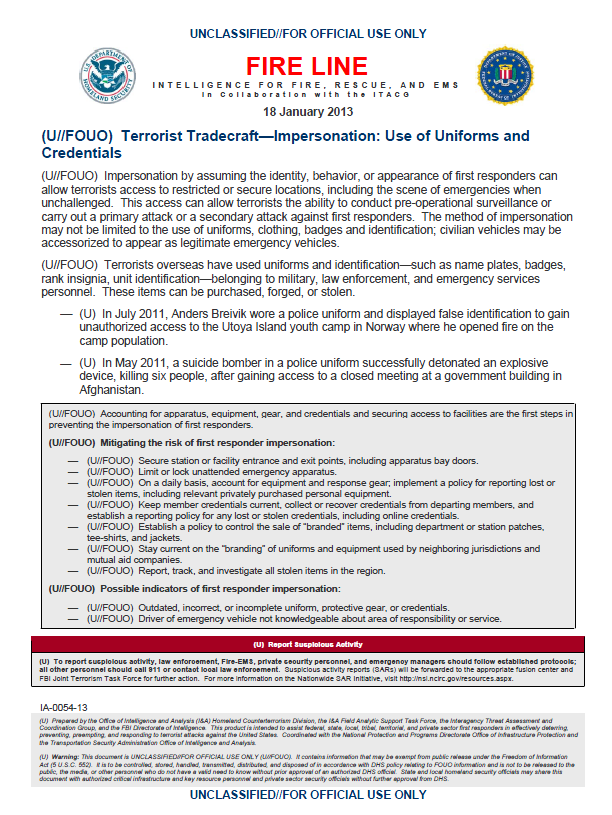Terrorist Tradecraft—Impersonation: Use of Uniforms and Credentials
- 1 page
- January 18, 2013
(U//FOUO) Impersonation by assuming the identity, behavior, or appearance of first responders can allow terrorists access to restricted or secure locations, including the scene of emergencies when unchallenged. This access can allow terrorists the ability to conduct pre-operational surveillance or carry out a primary attack or a secondary attack against first responders. The method of impersonation may not be limited to the use of uniforms, clothing, badges and identification; civilian vehicles may be accessorized to appear as legitimate emergency vehicles.
(U//FOUO) Terrorists overseas have used uniforms and identification—such as name plates, badges, rank insignia, unit identification—belonging to military, law enforcement, and emergency services personnel. These items can be purchased, forged, or stolen.
— (U) In July 2011, Anders Breivik wore a police uniform and displayed false identification to gain unauthorized access to the Utoya Island youth camp in Norway where he opened fire on the camp population.
— (U) In May 2011, a suicide bomber in a police uniform successfully detonated an explosive device, killing six people, after gaining access to a closed meeting at a government building in Afghanistan.
(U//FOUO) Accounting for apparatus, equipment, gear, and credentials and securing access to facilities are the first steps in preventing the impersonation of first responders.
(U//FOUO) Mitigating the risk of first responder impersonation:
— (U//FOUO) Secure station or facility entrance and exit points, including apparatus bay doors.
— (U//FOUO) Limit or lock unattended emergency apparatus.
— (U//FOUO) On a daily basis, account for equipment and response gear; implement a policy for reporting lost or stolen items, including relevant privately purchased personal equipment.
— (U//FOUO) Keep member credentials current, collect or recover credentials from departing members, and establish a reporting policy for any lost or stolen credentials, including online credentials.
— (U//FOUO) Establish a policy to control the sale of “branded” items, including department or station patches, tee-shirts, and jackets.
— (U//FOUO) Stay current on the “branding” of uniforms and equipment used by neighboring jurisdictions and mutual aid companies.
— (U//FOUO) Report, track, and investigate all stolen items in the region.(U//FOUO) Possible indicators of first responder impersonation:
— (U//FOUO) Outdated, incorrect, or incomplete uniform, protective gear, or credentials.
— (U//FOUO) Driver of emergency vehicle not knowledgeable about area of responsibility or service.

